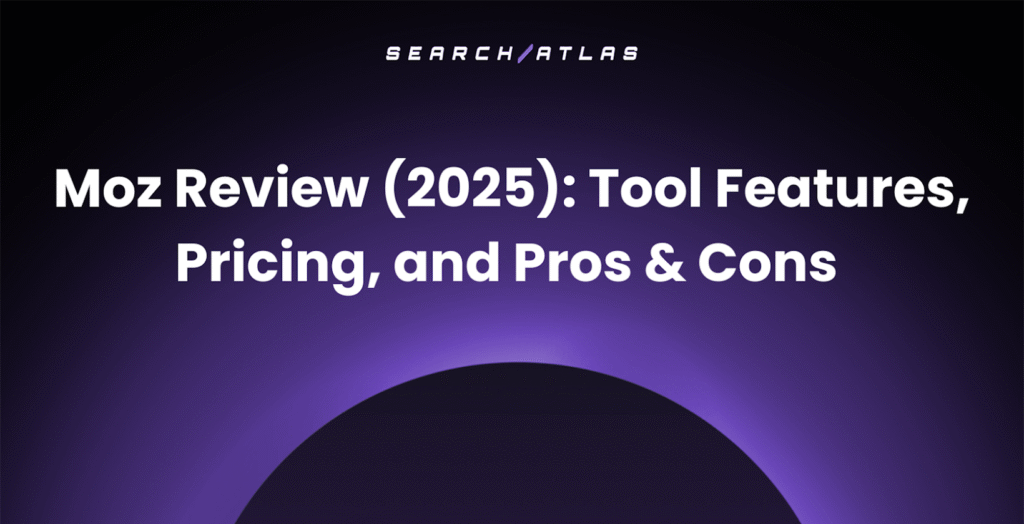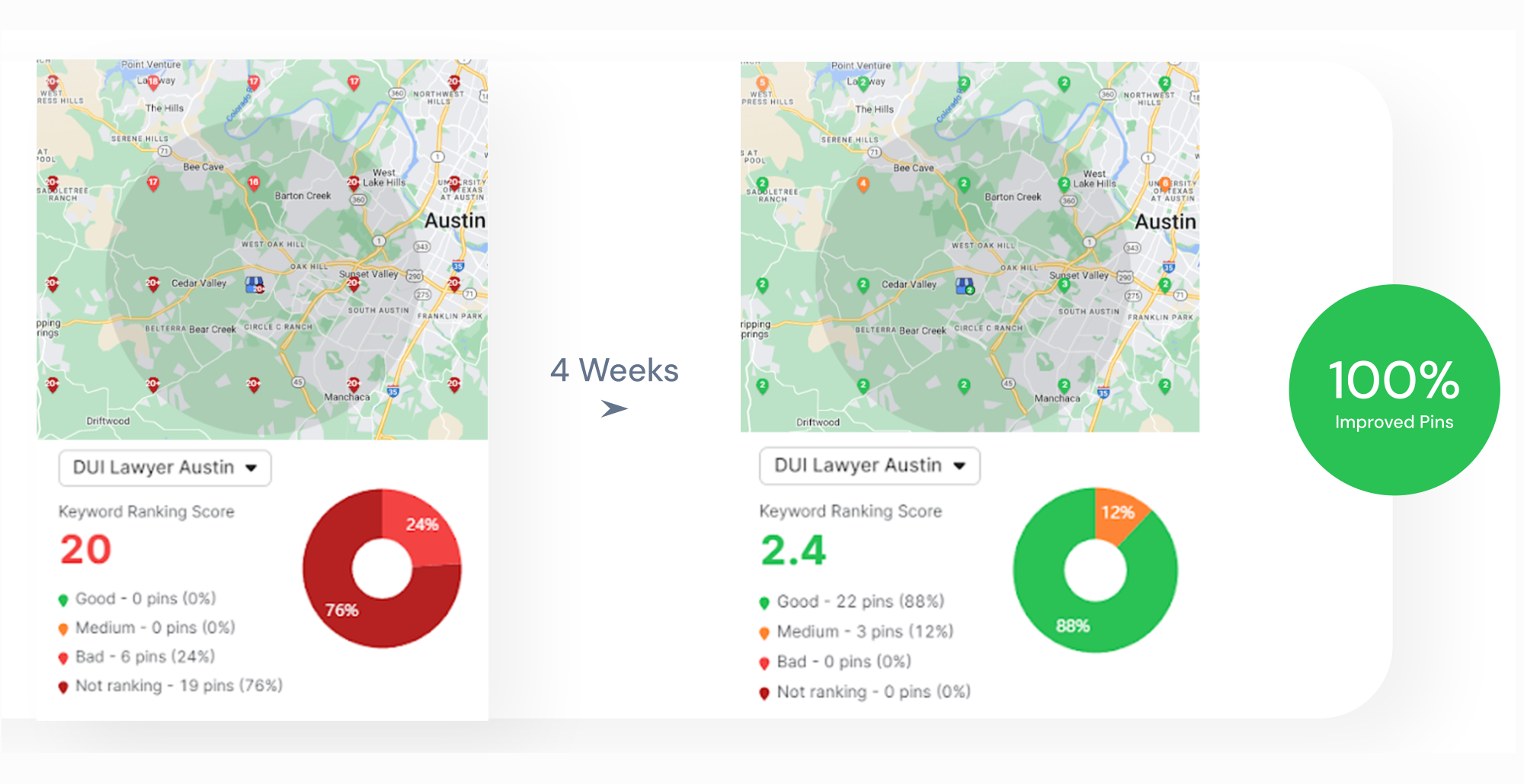Is your site traffic stagnate after making a bunch of technical SEO changes? Are you seeing little movement in your keyword positions after producing new content?
Whoops… 😅
It’s easy to make SEO mistakes across your site and sometimes you don’t even realize you’re making them. But these hidden errors can quietly sabotage your rankings, traffic, and conversions.
SEO mistakes are often accidental and created when updating another issue. So, that small fix you made might have increased your page load time. And data shows something as simple as a few seconds added to site load speeds drastically increase bounce rates.
Mistakes happen, but we’re here to help spot, prevent, and fix them! Don’t let small missteps cost you big results. Instead, dive into our ultimate list of SEO mistakes to avoid so you get the most out of your optimization efforts!

40 Common SEO Mistakes to Know & Avoid in 2025
We all know mistakes happen. But you don’t have to let them go unattended to! Check out our ultimate list of the 40 common SEO mistakes to know and avoid, while learning how to actually fix them. Also, we’ve bucketed the different types of mistakes into these core groups:
- Link Mistakes
- Keyword Mistakes
- Content Mistakes
- Technical SEO Mistakes
- Crawlability Mistakes
- On-Page SEO Mistakes
- Conversion SEO Mistakes
Link Mistakes
Look for these common link mistakes because they negatively impact your site’s authority, rankings, and crawlability, which will potentially harm your overall performance in search results:
1. Low Quality Backlinks
The quality of links is essential to the credibility and overall authority of your site. In fact, backlinks are often considered one of Google’s most important ranking factors.
The SEO mistake is many don’t monitor or regularly review whether or not their site is linking to or being linked from spammy, irrelevant sites. This is a pretty easy fix for most SEOs that can access a backlink analyzer tool.

These SEO tools allow you to see backlinks and referring domains in your website’s backlink profile. Your website has a much better chance to rank across search engines when you have more quality backlinks. Make sure you have a proper link strategy for your site to get the most value out of your incoming and outgoing links.
2. Buying Links vs. Earned Links
If you’re unsure on the differences between bought and earned, remember this: Earned links are backlinks you get naturally because your content is high-quality and relevant. They’re great for sustainable SEO and are much better for your business than buying links.
These links aren’t bought or traded—they come from other site owners, bloggers, or creators who genuinely find your content valuable and want to share it with their audience.
Buying backlinks, on the other hand, goes against Google’s Webmaster Guidelines. If you’re caught, you risk a Google penalty that can tank your search rankings. 🚫
While buying links is still a common SEO shortcut, it’s not worth the gamble. This is a common SEO mistake that could turn into a huge collapse in your site’s authority with search engines.
Instead, focus on building real partnerships through guest posts, collaborating with similar businesses, and creating content that provides value to everyone involved.
3. Lack of Internal Links
Not using enough internal links is another common SEO mistake that only does more harm than good. Without them, it’s harder for both users and search engines to navigate your site.
Internal links connect your content, helping visitors discover more of your pages and giving search engines a clear map of your site’s structure. Then, important pages go unnoticed and your rankings suffer.
For search engines, internal links signal which pages are most valuable. When you skip linking between pages, you miss an opportunity to distribute “link equity,” which boosts the authority of specific pages and improves their chances of ranking.

To avoid this mistake, link relevant pages naturally within your content. Use descriptive anchor text that reflects the linked page’s topic. ⚓
Also, regularly review your site to ensure older pages link to newer ones and vice versa. Identify opportunities for better internal linking and when done right, they’ll improve usability, guide search engines, and help you get the most out of your content.
4. Wrong Anchor Text or Over-Use of Anchor Links
Anchor text is a key part of SEO, but it’s often overlooked. This clickable text in hyperlinks helps both users and search engines understand what the linked page is about. If you use it effectively, it can improve your site’s ranking and visibility.
It’s important to find a balance between exact-match anchor text (using keywords directly) and varied, natural-sounding phrases. Overusing exact matches can seem unnatural to search engines and might even hurt your SEO.
| Anchor Text Type | Definition | SEO Impact |
|---|---|---|
| Exact Match | Anchor text that precisely matches a target keyword or phrase | Can enhance relevance for specific terms but risks over-optimization if overused |
| Varied and Natural | Anchor text that incorporates relevant keywords in a more contextual and diverse manner | Creates a more organic user experience and avoids penalties associated with keyword stuffing |
If you choose it thoughtfully, it strengthens the link’s value and can boost your page’s authority. But be careful not to over-optimize, which can look manipulative to search engines. To get it right, audit your site’s anchor text regularly, making sure it’s diverse, relevant, and natural.
Instead, try mixing things up with relevant, context-rich anchor text that guides users through your content while signaling relevance to search engines. Anchor text gives search engines important clues about the linked page’s content. 🔎
5. Too Many Broken Links
Broken links are pretty common—especially with larger websites that have thousands of pages. But it doesn’t mean fixing them is any less important.
Broken links are a common SEO mistake because they hurt both user experience and search engine rankings. When users encounter broken links, it leads to frustration and higher bounce rates. ⛓️💥

Search engines also struggle to crawl and index pages with broken links, which can hurt your site’s visibility. Regularly checking and fixing broken links ensures your site remains accessible and user-friendly, helping maintain good SEO and improving your site’s credibility.
6. Nofollow links
On the other hand, nofollow links are a common SEO mistake when used excessively or incorrectly. They simply don’t pass link authority to the target page, which can can limit your site’s ability to rank higher in search results.
While nofollow links are useful for certain purposes (like comments or ads), relying on them too much can prevent valuable link equity from reaching the right pages. Fix this by using nofollow links strategically and ensuring important links are dofollow to improve SEO.
Keyword Mistakes
Mastering keyword optimization and performance tracking is no small feat for SEOs. Try to avoid these common keyword mistakes:
7. Lack of Keyword Tracking
It might sound obvious to some, but without proper keyword tracking, you’re making a massive SEO mistake that leaves you flying aimlessly. Without tracking which keywords are driving traffic and ranking well, you can’t assess your SEO efforts or adjust strategies effectively.
What does this do? well, it certainly makes it hard to know what’s working and what isn’t, leading to missed opportunities. No proper keyword tracking means you might focus on the wrong keywords, overlook valuable ones, or fail to notice if your rankings drop. ⬇️
It also makes it difficult to spot trends, adjust content, or optimize for new search terms as they emerge. And this is a common mistake for SEOs because it can be easy to overlook in favor of immediate tactics like content creation or link-building.
Additionally, many SEOs may focus on rankings in a general sense without digging into the specifics of keyword performance, or they might assume that tools like Google Analytics automatically provide all the insights needed.
To avoid this mistake, regularly track your targeted keywords’ rankings, search volumes, and performance over time. Use SEO tools to monitor shifts and make data-driven decisions to refine your strategy and improve your site’s visibility.
8. Keyword Density Issues or Stuffing
Getting great search rankings starts with smart keyword use—but some tools have us going overboard, which leads to keyword stuffing. This misktake can backfire big time.
Instead of boosting your rankings, stuffing your content with too many keywords can get your site penalized and hurt your credibility. Keyword stuffing used to work in the early days of SEO, but search engines have evolved.
Now, algorithms are designed to catch manipulative tactics and prioritize content that feels natural and helpful. If your page is packed with repetitive keywords, it’s not just search engines you’ll annoy—your audience will lose interest too. 🥱
The key is balance. Focus on creating high-quality content that flows naturally and uses keywords in a way that makes sense. Tools can help you find the right keyword density, but always prioritize your readers’ experience.

By steering clear of keyword stuffing and embracing natural language, you’ll not only keep search engines happy but also build trust with your audience. Remember, great SEO isn’t about tricking algorithms—it’s about delivering value to the people searching for your content.
9. Keyword Cannibalization
Another keyword mistake is due to—often unknowingly—cannibalizing your own keywords. If you have multiple pages targeting the same keyword, you’re going to run into a cannibalization issue—essentially pitting your own pages against one another in the SERPs.

There are plenty of tools like Google Search Console that can help you find cannibalization issues. But tools like Search Atlas take a step further with features like Page Pruning to find your worst performing pages and get recommendations on what to do with them.
10. Ignoring Keyword Difficulty Metrics
For many SEOs, it’s always tempting to go after the big search volume keywords. But we know (or should know) that competitive keywords are especially hard to win as you’re starting off.
The easiest way to fix this SEO mistake is to prioritize keywords you know you can win by using tools that analyze keyword difficulty. These tools are essential because understanding keyword difficulty works like our reality check that helps us focus on keywords we actually have a shot at ranking for, based on our site’s authority.
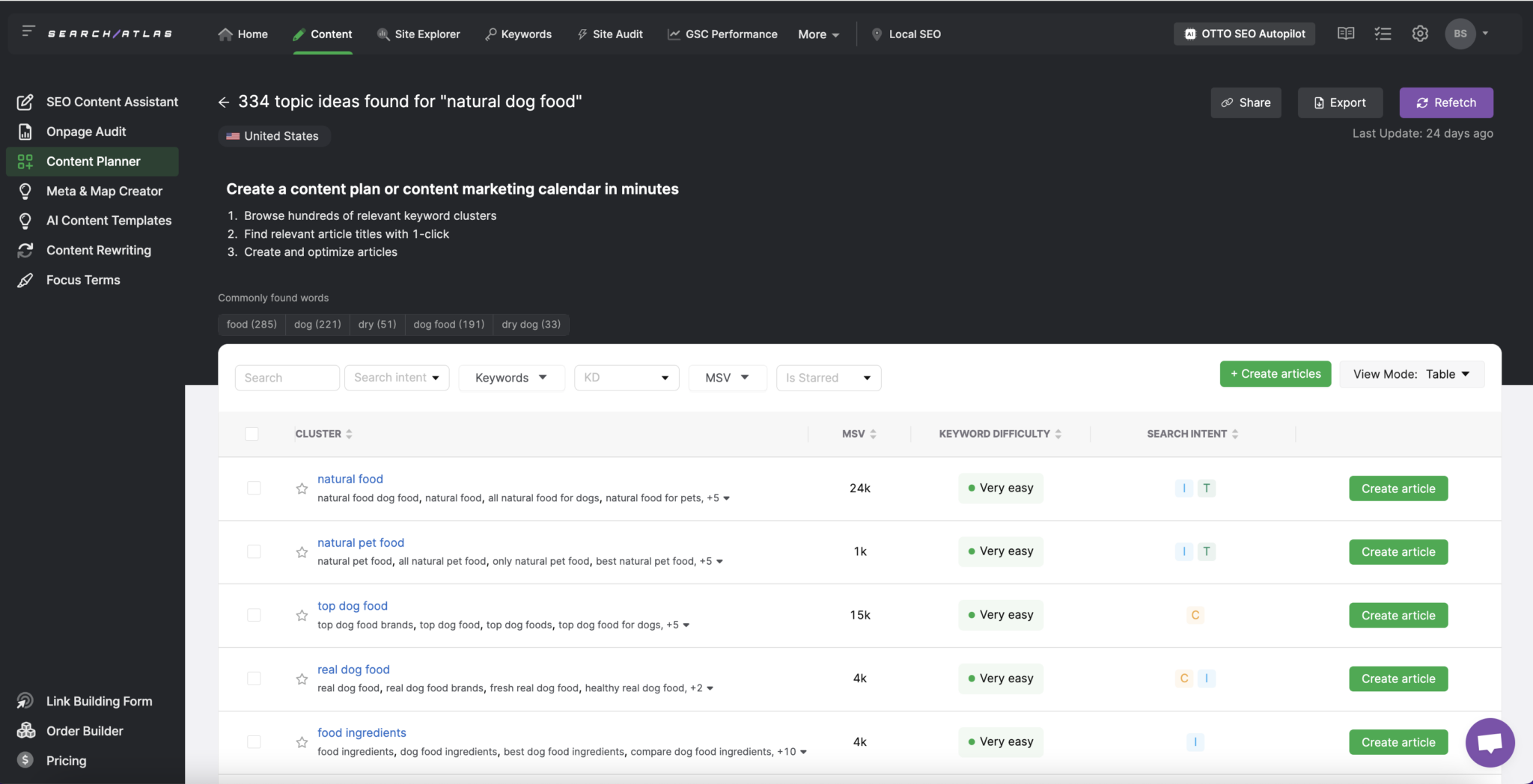
By understanding this metric, we can be smarter about where to put our energy. Instead of chasing impossible keywords, we can prioritize ones that give us a real chance to rank well and bring in the right traffic. It’s all about working smarter, not harder, when planning content and resources. 🧠
Content Mistakes
We know content is king and for your SEO efforts, quality is key. Make sure you’re taking the right steps by avoiding these common SEO content mistakes:
11. Low Quality of Content
What’s the real secret to SEO success? Unique content.
Every page should offer something fresh and valuable, whether it’s a product description, blog post, or landing page. Not only does this help your site stand out, but it also keeps search engines—and visitors—coming back for more.
The biggest mistake made by SEOs is bypassing the quality for optimizations. Additionally, many SEOs don’t analyze their own content vs. the competition.

There are powerful competitive content analysis tools to see exactly how you compare to other ranking sites. They can even provide detailed recommendations to
12. Improper or Unintentional Use of AI
Over-relying on AI for SEO content is a common mistake because…it’s easy. 🤖
While AI can generate content quickly, it often lacks the nuance, creativity, and deep understanding that human writers bring. AI may produce keyword-stuffed or generic content that doesn’t engage readers or align with their intent that will lead to poor user experience and higher bounce rates.
Additionally, AI-generated content may struggle to fully grasp brand voice or the unique needs of your audience. It can also miss context, which can result in content that feels robotic or off-topic, failing to build trust with users.
From an SEO perspective, search engines are increasingly prioritizing high-quality, original, and valuable content. If your content sounds repetitive or artificial, search engines may penalize your site or lower its rankings.

However, AI can be an incredibly valuable tool to help get certain aspects of content produced quickly—especially when starting from scratch. Using tools like the Search Atlas Content Assistant and its OTTO SEO feature can be a helpful tool to get quality AI-generated content for various landing pages, technical SEO aspects (i.e. meta tags, schema markup), and even certain blog creation.
Whether you’re researching or drafting, or needing to enhance the content, Search Atlas helps you ensure your content is well-written, insightful, and tailored to your audience. Striking a balance between AI assistance and human expertise is key to creating SEO content that truly resonates and ranks well.
13. No Consideration for Natural Language and Semantic Search
It’s safe to say search engine algorithms are extremely complex and diligent. Unfortunately, a common SEO mistake is not incorporating natural language into their content creation. This involves using a conversational tone that mirrors how your potential customers might phrase their search queries.
Think of the different types of content you’d want to appear when searching for the best available credit cards for travelers vs. a search query on how to actually fold bed sheets. Content relevance and user experience is key here.
| SEO Strategy Component | Definition | Impact on Ranking |
|---|---|---|
| Natural Language Use | Adoption of a conversational tone that reflects actual user queries | Enhanced content relevance and improved user experience |
| Semantic Search Practices | Creating content that considers the context and intent behind search queries | Better alignment with user intent, leading to higher search engine favorability |
Also, semantic search allows businesses to align content with the intent behind user searches. By focusing on the context in which target keywords are used, you can create rich, meaningful material that search engines favor, which helps you improve your organic search performance.
14. Poorly Structured Content and Use of Headers
Poorly structured content and misused headers are common SEO mistakes that can hurt your rankings. Headers (H1, H2, H3, etc.) act as a roadmap for both readers and search engines, helping everyone understand the main points of your content.
Without clear structure, pages can feel messy, confusing visitors and search engines alike. To avoid these issues, keep your headers logical and organized. This simple fix can boost engagement, improve navigation, and help search engines rank your content higher.

Misusing headers—like skipping levels or overloading with H1s—makes it harder for search engines to understand your content. For users, good headers break up long text, improve readability, and highlight key points.
15. Duplicate Content
SEO can be tricky, and one of the biggest mistakes to avoid is duplicate content. It’s a sneaky issue that can pop up in various ways and hurt your rankings if left unchecked.
Duplicate content can show up as identical product descriptions across pages or repeated text blocks. Even technical hiccups, like having both www and non-www versions of your site accessible, can cause problems. The key is spotting these issues early and addressing them.
Canonical tags are your best friend here. These handy HTML elements tell search engines which version of a page is the primary one, preventing confusion and protecting your rankings. Think of them as your site’s way of saying, “This is the real deal—index this!”
16. Low or Too High Word Count
A very common SEO mistake is thinking the higher the word count, the better your content will rank. That’s simply just not true because search engines will deem your content “thin,” which you can read more about further down.
However, another mistake is completely ignoring content lengths all together. Instead—especially if you’re at the beginning stages of improving your site—simply track your content’s word count to understand what lengths are performing the best.

There are plenty of SEO Chrome Extension tools out there, but you can even use use free ones like Word Counter Plus to quickly pull word counts.
Technical SEO Mistakes
Technical SEO fixes are some of the most complicated tasks for SEOs, which means mistakes happen often. Ensure your technical SEO expertise hits the mark by avoiding these mistakes:
17. Slow Site Speeds
Optimizing site speed is a crucial factor in the user’s experience and a determinant in search engine ranking algorithms. A quick-loading page isn’t a site luxury—it’s a necessity for engaging users, reducing bounce rates, and edging out competitors in the SERPs.
You can remedy this SEO mistake by starting with a thorough analysis of your current load times. It’s smart to invest in comprehensive site speed assessments where you can get granular insights into the performance of each web page.

This will help you establish realistic and measurable benchmarks against industry standards. Additionally, site owners aiming to optimize their search rankings understand the importance of leveraging browser caching.
By enabling this feature, you ensure that repeat visitors experience quicker load times, as static resources are stored locally in the user’s browser, reducing server load and wait time on subsequent visits. ️💨
18. Lack of Browser Caching
As your site starts to grow, browser caching becomes a must-have. But many SEOs don’t prioritize this on their site, which can be preventative in your overall organic growth.
This strategic approach not only improves the user experience for returning users but also contributes positively to a website’s performance metrics. Search engines, recognizing the enhanced speed and efficiency, often reward such practices with improved search result positioning, creating a virtuous cycle benefitting both the visitor and your site!
19. Sitemap Not Submitted, Overloaded, or Has Broken Links
Simply put, sitemaps are your site’s roadmap for search engines, but there are several oversights that can derail their effectiveness. Some of the most common SEO mistakes with sitemaps include:
- Skipping Submission: It may see obvious, but you must submit your sitemap to Google Search Console or Bing Webmaster Tools to ensure it’s actually seen in the first place.
- Overloaded Sitemap Files: Another common mistake is trying to fit everything into one single robots.txt file. Limit each file to 50,000 URLs or 50MB—and if needed—split into smaller sitemaps using a sitemap index.
- Broken or Redirecting Links: Having 404 errors or unnecessary redirects on your sitemap will only hurt your efforts. Perform regular audits to fix or remove sitemap link errors.

Validate your sitemap by easily connecting Google Search Console to your Search Atlas account. Audit your sitemap from Search Atlas and make sure you don’t forget to list it in your robots.txt file!
A clean and up-to-date sitemap drastically helps search engines understand your site and improves indexing. ️🧹
20. Lacking or Incorrect Schema Markup
Schema markup optimizations can be one of the trickier technical SEO aspects without the proper web development knowledge. However, it shouldn’t drop in priority if you simply don’t know how to add markup to your pages.
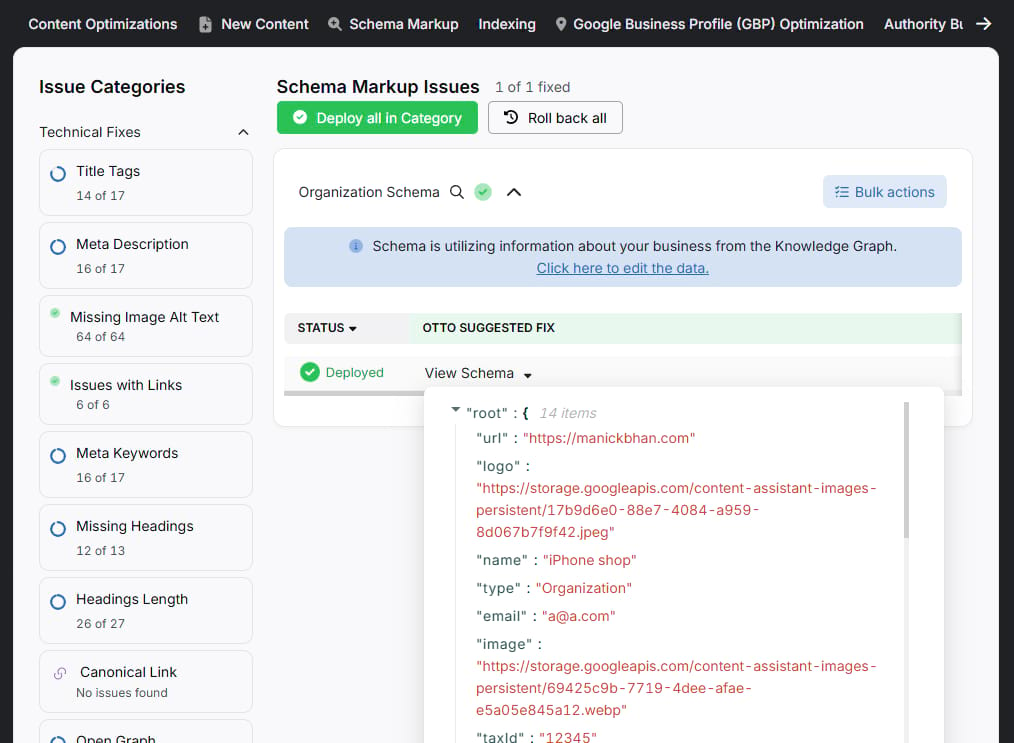
Tools like OTTO provide recommendations for schema markup across pages and even give you the option to click to deploy the changes—all without the need for a developer.
21. Overly Long or Keyword-less URL Slugs
Don’t make the mistake of using overly long or keyword-less URL slugs! They can hurt SEO because they’re harder for search engines and users to understand.
Search engines rely on URLs to get a quick sense of what a page is about. If your slug is long, vague, or missing relevant keywords, it reduces clarity and can impact rankings. For users, short, keyword-rich slugs are more readable and trustworthy.
A clean URL is far more appealing and easier to read:
- example.com/seo-mistakes
Overly long and irrelevant slugs can confuse readers and discourage clicks:
- example.com/4930/page37?id=1010294
Just keep slugs concise, include target keywords naturally, and avoid unnecessary words or characters. This improves both SEO and user experience. 🤝
22. No Mobile-First Indexing
Google’s mobile-first indexing has become the standard of search engine optimization. In fact, Google predominantly uses the mobile version of the content for indexing and ranking.
Site owners who disregard switching to mobile-first indexing face the risk of diminished search rankings, as mobile-first indexing prioritizes user experience on handheld devices. That’s why it’s critical to have regular mobile compatibility checks to maintain your site’s performance with mobile device usage.

Ensure your web pages render flawlessly, with assets loading efficiently to secure a low bounce rate and high engagement levels. Using an On-page audit tool can help you conduct mobile audits and identify site speed, navigation, and readability issues and even provide recommendations on how to fix them
23. No Responsive Design
A non-responsive design is a common SEO mistake because it can hurt both user experience and search engine rankings. As we just mentioned, more people browsing on mobile devices, which has search engines like Google prioritizing mobile-friendly sites.
If your site doesn’t adjust to different screen sizes, it creates a frustrating experience for mobile users, which can lead to higher bounce rates and lower engagement. Google also uses mobile-first indexing, meaning it looks at your mobile site to determine rankings.
If your site isn’t responsive, you may see some negative effects. To fix it, make sure your site adapts smoothly to all screen sizes with proper QA testing and on-page SEO audit tools.
24. Non-Secure Pages (No SSL Certificate)
While it might sound like a mistake made several years ago, sites still exist without an SSL Certificate. Non-secure pages (those without an SSL certificate) are a common SEO mistake because they can negatively affect both user trust and search engine rankings. 🔓
SSL certificates encrypt data between the user and the server, ensuring that sensitive information remains secure. Google prioritizes secure sites, and if your site isn’t protected, it may be marked as “Not Secure” in browsers, which can scare visitors away.
Additionally, Google uses HTTPS as a ranking signal, meaning sites without SSL certificates are less likely to rank well in search results. To avoid this mistake, make sure your site has an SSL certificate, making it secure (with “https://” in the URL).
Crawlability SEO Mistakes
Easily crawlable sites give you the edge against your competition because Google will understand your content and pages faster. So, make sure you steer clear of these common crawlability errors to keep your site performing in the right direction:
25. Too Many Not Indexed Pages
Not indexed pages are a big and common SEO mistake because they essentially disappear from search engine results. This makes it impossible for users to find them through organic search.
If important pages on your site aren’t indexed, you miss out on potential traffic, as those pages won’t show up in search results, no matter how good the content is. The mistake comes from not properly and regularly tracking not indexed pages.
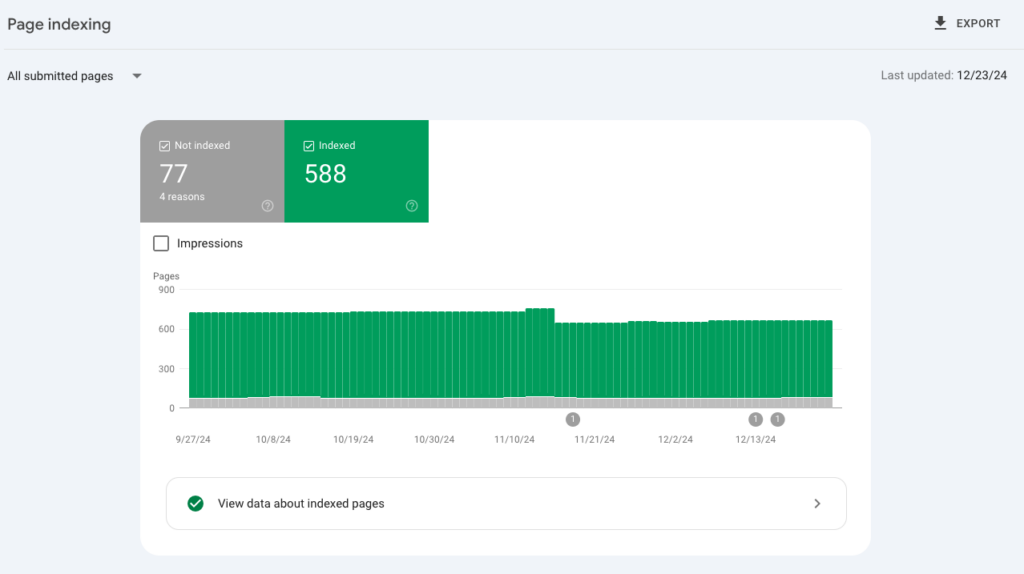
It’s important to know that pages might not be indexed due to technical issues like incorrect robots.txt settings, noindex tags, or crawl errors. If search engines can’t access and index these pages, they won’t contribute to your SEO efforts.
To avoid this mistake, regularly check your site’s index status in Google Search Console or other technical SEO tools and ensure that all important pages are set up for indexing. This way, your content has the chance to rank and drive traffic.
26. Missing Robots.txt file
Speaking of robots.txt files, a regular SEO mistake is accidentally blocking important pages from search engines by using broad “Disallow” rules. This can stop pages from being indexed and hurt your site’s visibility in search results. Other issues can include:
- Blocking essential assets like CSS or JavaScript, which can mess with how search engines render your pages.
- Syntax errors, like typos or missing slashes, causing pages to be blocked.
- Not having a robots.txt file at all, which can lead to unnecessary pages being crawled.
- Leaving outdated rules in place from a previous site version, unintentionally blocking important pages.
- Forgetting to review and update the file as your site changes.
- Using “Disallow” instead of “noindex” meta tags for pages you want to block from indexing.
- Overusing wildcards that block dynamic content, including important pages.

To avoid these mistakes, regularly check and update your robots.txt file to make sure it’s guiding search engines properly, and that all the right pages are being indexed.
27. Too Many Redirect Loops
Another common crawlability SEO mistake is creating a redirect loop where a website keeps sending users in circles. It redirects users from one page to another, and back again, which the cycle prevents users from reaching their destination. 🔁

Redirect loops can hurt your SEO efforts by:
- Lost link equity: Search engine crawlers can’t pass link authority through a redirect loop, hurting your page’s ranking potential.
- Poor user experience: Users get stuck in an endless loop or face slow loading times, leading to frustration and potential site abandonment.
- Crawling issues: Search engines might stop crawling your site if they hit too many redirects, affecting how often your pages get indexed.
To avoid redirect loops, simply review your redirect rules to ensure there are no circular redirects. Then, make sure you’re using proper redirect codes (i.e. permanent changes should always use a 301 redirect to pass link authority correctly).
By staying on top of your redirects, you can avoid loops and keep your site in good shape for both users and search engines.
28. Excess 3XX, 4XX, and 5XX Status Codes
Simply put, having too many 3XX (redirects), 4XX (client errors), and 5XX (server errors) status codes is bad for SEO. Why? For starters, they prevent search engines from crawling and indexing your site properly.
Redirects can slow down crawling, 4XX errors signal broken pages, and 5XX errors indicate server issues. These problems lead to poor user experience, lower rankings, and reduced crawl efficiency, harming your site’s visibility.

It’s a common mistake because issues like outdated URLs, misconfigurations, or server problems often go unnoticed until they affect SEO performance. That’s why it’s so important to monitor your site’s health and find URL issues and fix them before they cause major harm.
On-Page SEO Mistakes
There are a ton of factors to consider with on-page optimizations, which is why there are so many common mistakes. Feel confident with your on-page SEO efforts and watch out for these errors:
29. Non-Optimized Image Files
Optimizing images holds a significant role in diminishing load times, a core aspect often overlooked by businesses aiming to ascend in search rankings.
By resizing and compressing images, you website can realize marked load time reductions, creating a more seamless browsing experience that caters to your audience’s expectations for prompt content delivery. If you diligently follow these guidelines, you’ll ensure your images strike the appropriate balance between quality and quick display.
On the other hand, compressing files can revamp the site’s overall speed by condensing the size of CSS, JavaScript, and HTML files. Site owners who leverage file compression often witness a sizeable boost in their site’s performance metrics.

There are free tools out there like ImageOptim that quickly compress media files—without massively changing the quality. All of this can lead better ranking positions in search results and improved user experiences that could increase conversions.
30. No Image Alt Text
One of the most looked-over optimizations is the basic practice of adding Alt Text to images. While some SEOs will downplay its importance, it’s good to know that alt text works for your site in two ways:
- Provides Accessibility: Alt text gives blind readers descriptions of the images within the page’s text, so they can better understand the purpose of the image and to know how the overall page is laid out.
- Keyword Opportunities: While you want to avoid overusing keywords, alt text provides a great chance to use relevant keywords to help search engines read your content and potentially help rank your images on image search engines.
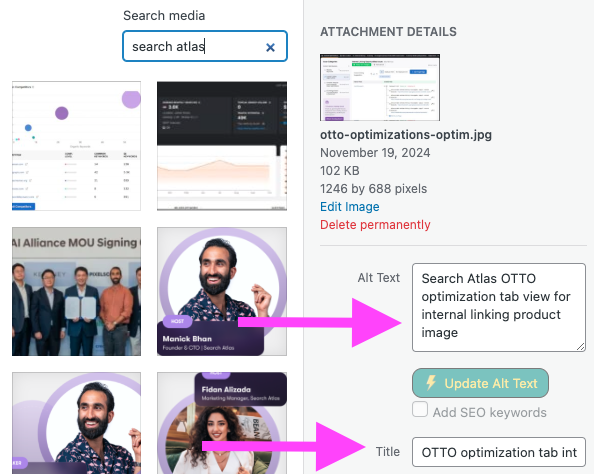
Don’t overthink your alt text naming process. In fact, you can use SEO tools to find images without alt text and get recommended copy to use for your media files.
31. Poor Meta Title Strategy (Length and Keyword Usage)
Meta titles—or title tags—are often seen as a minimal impact optimization, but simply giving them a little more attention could really improve your SEO efforts. One mistake is simply avoiding meta tag optimization. Another is writing meta titles without the primary keyword or placing the keyword in the wrong place.
You only have about 70 characters to show your full title tag on search engines but placement is key. At the same time, so is the length.

Overly long title tags tend to be rewritten by search engines or appear on pages without the full context. While meta titles are critical to SEO, luckily, there are powerful SEO tools out there that can find and provide recommended meta titles for your pages to make the process a breeze.

Additionally, you should always test and refine. With A/B testing and performance analytics, we can learn what resonates with our audience and optimize our meta descriptions for better results. ⚖️
When we get it right, these small tweaks can drive more organic traffic and strengthen our online presence.
32. No Meta Description Optimization
Every detail matters in SEO—and meta descriptions are one of the easiest ways we can influence search visibility and boost click-through rates (CTR). Data shows that Google tends to rewrite or add its own meta descriptions for your ranking pages, which has caused some SEOs to avoid adding in their process.
But these short snippets, appearing under page titles in search results, act as mini ads, inviting users to explore our content—which is why it’s better for you to write than a search engine.
Just like your meta titles, using targeted keywords and compelling language gives you the chance to showcase the value of your content in just a few words, making them a critical part of our SEO strategy. The first step is simply finding all your pages that don’t have them.
Conversion SEO Mistakes
Improving keyword rankings and traffic is great, but you can’t forget about how you’ll convert that traffic into paying customers. Avoid these common pitfalls to keep your customers coverting:
33. Lack of CTAs (Not Keeping Visitors On the Page)
A single “signup” or “buy now” won’t do the trick to covert users on your pages or keep them there in the first place. If users don’t have a clear next step, you’ll likely see increased bounce rates and lower engagement, which are both negative signals for search engines.
Fix this common SEO mistake by placing CTAs prominently on pages (think above the fold or after valuable content). Also, make sure they are visually distinct and easy to click. Well-placed CTAs improve user experience and boost both SEO performance and conversions.
Try to add compelling, contextually relevant CTAs that align with the page’s intent. For example:
- Blog posts: Link to related articles or downloadable resources.
- Product pages: Use “Add to Cart” or “Learn More.”
- Landing pages: Focus on primary actions like “Sign Up” or “Get Started.”
34. Ignored Page Scroll Depth
Page scroll depth is often overlooked in SEO because it’s not a direct ranking factor. However, it does reflect user engagement.
If visitors leave before scrolling, it signals that the content isn’t engaging or relevant, which can hurt metrics like dwell time and increase bounce rates—both indirect SEO factors.

There are visual tools to measure scroll depth and identify where users drop off. Or you can use the tried-and-true Google Analytics to set up Google Tag Manager and create scroll-depth events.
You can fix these common SEO mistakes by addressing:
- Content layouts: Break up text with headings, images, or videos.
- Skimmable content: Use bullet points or summaries to hook readers.
- Adding CTAs: Like we previously mentioned, encourage interactions with strategically placed calls-to-action.
35. Poor User Experience Leading to Weak Rankings
In a nutshell, SEO helps your site show up in search results, while UX (user experience) focuses on how enjoyable and easy it is for visitors to use your site. When done correctly, a great UX creates a seamless, engaging experience that keeps visitors exploring, coming back, and taking action—like signing up or making a purchase.
It covers everything from fast load times and smooth navigation to visually appealing, high-quality content. Google pays attention to how users interact with your site, using metrics like time on page and clicks to gauge quality.

A strong SEO user experience supports your organic efforts by improving technical aspects like mobile-friendliness and load speed, making it easier for search engines to crawl and index your site.
The result? Happy visitors, better rankings, and organic traffic that grows over time. 😊
36. Inattentive Performance Tracking
Most SEOs are oriented to track organic performance, but one of the biggest mistakes comes from inattentive or irregular performance tracking. Why is it a critical issue? It leaves you blind to what’s working and what’s not.
Without monitoring, you may miss issues like dropping rankings, slow site speed, or high bounce rates—all of which impact visibility and traffic. SEO is dynamic, and failing to track performance means missed opportunities for optimization.
You have to make performance tracking a daily occurrence. Listen, we know it takes a lot of time to run through Google Analytics, Google Search Console, and other performance tools each day.
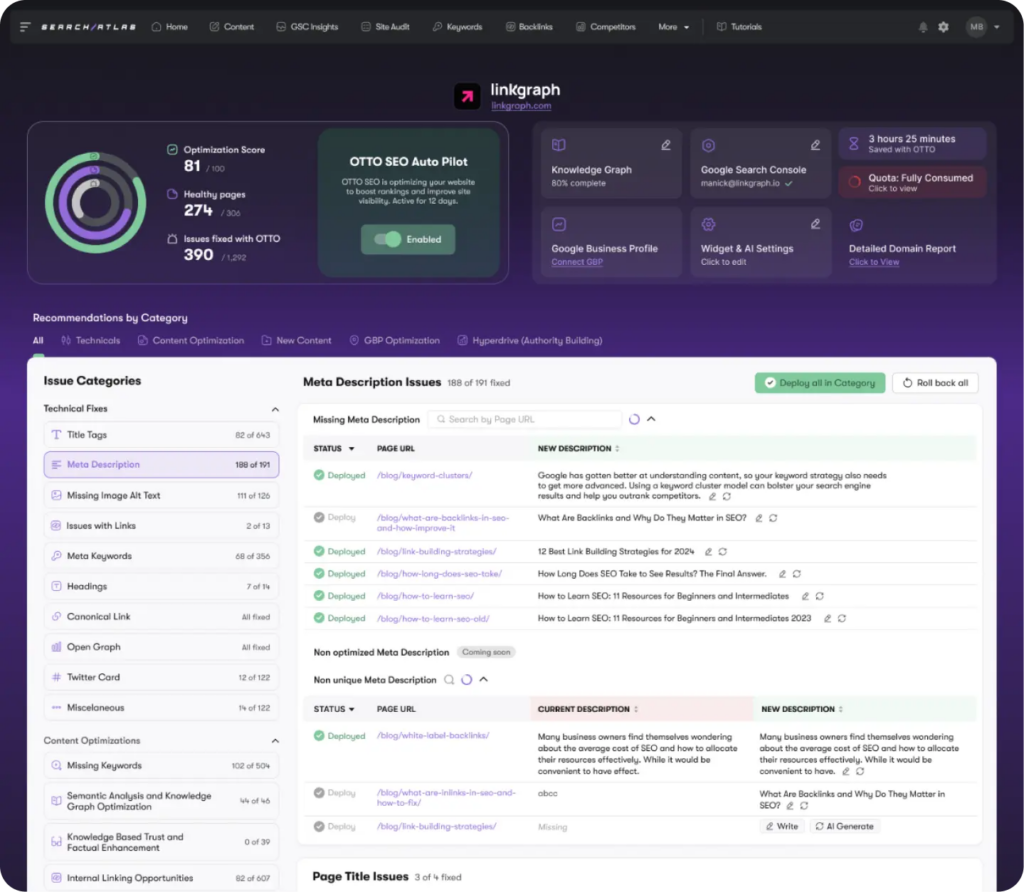
Instead, adopt an all-in-one SEO tool that can track key metrics like organic traffic, keyword rankings, page load times, UX, and every other aspect of your site that directly correlates to your site’s performance!
Easily set up regular reports and alerts for significant changes, uncover major issues, and analyze your site data to spot trends. At the end of the day, consistent performance tracking ensures your SEO efforts stay effective and aligned with search engine updates and user behavior.
Local SEO Mistakes
Some of the most common types of SEO mistakes occur from localization efforts. Stand out to your target area audience by avoiding or fixing these issues:
37. Unclaimed or Poorly Optimized Google Business Profile
Your Google Business Profile is key to helping you get discovered. But for many small businesses—whether just starting out or those lacking the manpower—it’s hard to craft the necessary content, know exactly what is needed in your GBP, and how to optimize it for greater success.
This leads to poorly optimized profiles or leaving GBPs unclaimed altogether. There’s no reason to let this mistake prevent your discoverability.
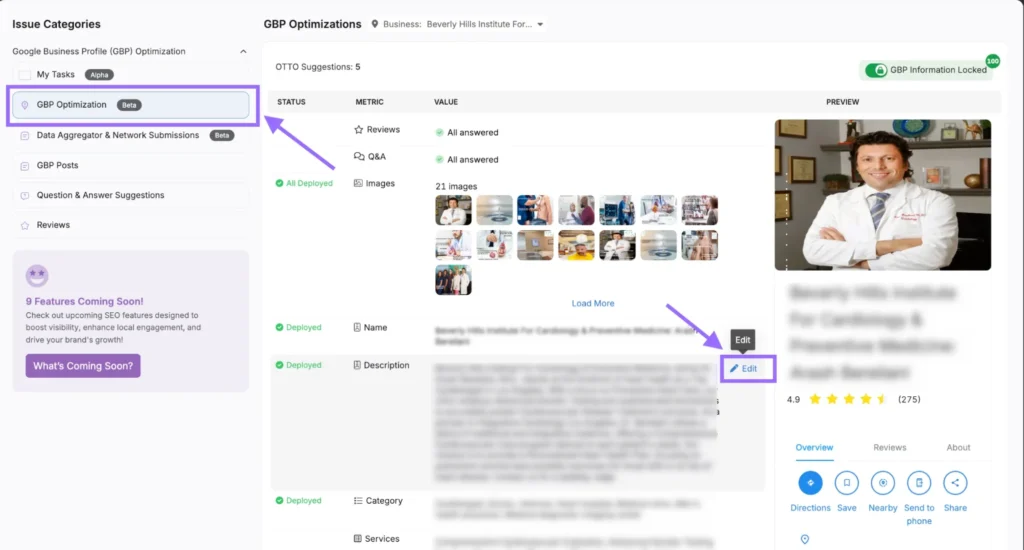
Using Google Business Profile Management Software will significantly help you check off every step in your GBP process without the need to hop back and forth between your profiles. Easily use AI to generate common Q&As, input automated review responses, and manage multiple profiles in one simple-to-use dashboard. ⚙️
38. Inconsistent Citations
Another common local SEO mistake is having inconsistent citations. This confuses search engines and users about your business’s accurate details.
Variations in your business name, address, or phone number (NAP) across directories, social platforms, and your website weaken your credibility and can hurt local search rankings if they don’t match or are not filled out to begin with.

Audit your citations using local SEO tools to spot these issues and keep your listings updated to ensure NAP details are the same everywhere. And yes, this includes Google Business Profile, Yelp, and other important directories for your business!
You can use Search Atlas’ Local Citation Builder & Data Aggregators to build citations across multiple networks simultaneously with an one-time payment—say goodbye to monthly subscriptions.
Use OTTO’s built-in schema feature on your site to reinforce consistency. Regularly review your citations to maintain accuracy, especially after changes like moving locations or rebranding. Consistent citations build trust with search engines and improve local visibility. 🧐
39. Lack of Localized Content
Many businesses, big and small, overlook localized content because it’s time-consuming to create and often seen as too much effort for the perceived impact. Without this content, you limit your ability to connect with local audiences and rank for location-specific searches.
Search engines prioritize content tailored to users’ locations, making generic content less effective for local SEO. That’s why you have to create content that speaks directly to your target area’s audience, such as city-specific blog posts, localized service pages, or event coverage.

If you’re short on time or resources, there are local SEO content tools you can use to implement geo-targeted keywords naturally in titles, meta descriptions, and headers. Additionally, these tools help you quickly create quality localized content to boost your visibility.
As we previously mentioned, make sure your business’s name, address, and phone number (NAP) are consistent across your website and local directories. You can also add location-specific schema markup to boost visibility.
If you consistently update your content to stay relevant to local trends and needs, you’ll strengthen your connection with the local audience and improve search rankings.
40. Minimal Local Keyword Tracking
Understanding your local keyword performance is one thing. But where many local SEOs and small businesses fall short is specific geographical tracking in local markets.
If you don’t know where you’re ranking in your exact target areas, your overall local keyword strategy might not reaping the rewards of your efforts.

See the real impact of your SEO efforts with Search Atlas’ local heat maps. Easily create customizable grids (up to 100 miles) to track their ranking positions in the Google Map Pack.
You can also view before-and-after tracking, time-of-day data, and adjust refresh intervals to stay on top of your efforts. Compare keyword visibility with local competitors, and share clear, visual reports in URL or PDF format.
Avoid Common SEO Mistakes and Invest in a Robust SEO Software Solution
As we’ve covered, there are a ton of SEO mistakes to be made. But don’t sweat it! There are ways to keep on top of your site’s performance and prevent the most common and technical mistakes from happening.
With the help of Search Atlas, you can thoroughly monitor your website, crawl it for technical issues, and even use features like OTTO to highlight core issues, provide recommended fixes, and the ability to deploy updates in just a few clicks!
Want to see it all in action? Don’t make the mistake of missing out. Test drive Search Atlas today with a free 7-day trial!




